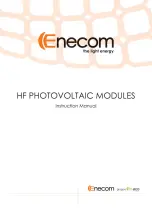
| 7
EN-Rev IM/GN-AM-EN/2.71 Copyright © June, 2021. CSI Solar Co., Ltd.
www.csisolar.com
Do not
immerse modules in water or
constantly expose modules to water (either
fresh or salt, i.e. from fountains, sea spray).
Exposing modules to salt (i.e. marine environments) or
sulfur (i.e. sulfur sources, volcanoes) incurs the risk of
module corrosion.
Do not expose modules and their connectors to any
unauthorized chemical substances (e.g. oil, lubricant,
pesticide, etc.), as modules may incur damages.
Canadian solar modules have passed salt mist
corrosion resistance test according to IEC 61701, but
the corrosion may still occur on where the modules
frame is connected to the bracket or where the
grounding is connected. Should the installation location
be near the ocean, Canadian solar recommends
stainless steel or aluminum materials be used in the
areas with direct contact with the PV modules, and the
connection point should be protected with anti-
corrosion measures. For more information, please
contact Canadian solar technical support team.
CS7L-MS & CS7N-MS modules, when used in rooftop
applications, should be installed in a way that ensures
enough ventilation. The clearance between lowest
point of module and the roof surface MUST be equal to
or greater than 102 mm, tilt angle of module to roof
surface should be equal to or greater than 15°, and
wind shields or decorative sheets which will prevent
ventilation around PV array are NOT allowed to be
installed.
Failure to comply with these instructions will void
Canadian Solar warranty.
INSTALLATION REQUIREMENTS
Ensure that the module meets the general technical
system requirements.
Ensure that other systems components do not damage
the module mechanically or electrically.
Modules can be wired in series to increase voltage or in
parallel to increase current. To connect modules in
series, connect the cables from the positive terminal of
one module to the negative terminal of the next module.
To connect in parallel, connect the cables from the
positive terminal of one module to the positive terminal
on the next module.
The quantity of bypass diodes in the module’s junction
box provided may vary depending on the model series.
Only connect the quantity of modules that corresponds
to the voltage specifications of the inverters used in the
system. In addition modules must not be connected
together to create a voltage higher than the maximum
permitted system voltage stated on the module
nameplate, even under the worst local temperature
conditions (see Table 1 for the correction coefficients
that apply to open-circuit voltage).
A maximum of two strings can be connected in parallel
without using an over-current protection device (fuses,
etc.) incorporated in series within each string. Three or
more strings can be connected in parallel if an
appropriate and certified over-current protection
device is installed in series within each string. And it
shall be ensured in the PV system design that the
reverse current of any particular string is lower than the
module maximum fuse rating at any circumstances.
Only modules with similar electrical parameters should
be connected in the same string to avoid or minimize
mismatch effects in arrays.
To minimize risk in the event of an indirect lightning
strike, avoid forming loops with the wiring when
designing the system.
The recommended maximum series fuse rating is
stated in a table in the Annex A.
Modules should be safely fixed to bear all expected
loads, including wind and snow loads.
A minimum clearance of 6.5 mm (0.25 in) between
modules is required to allow for thermal expansion of
the frames.








































